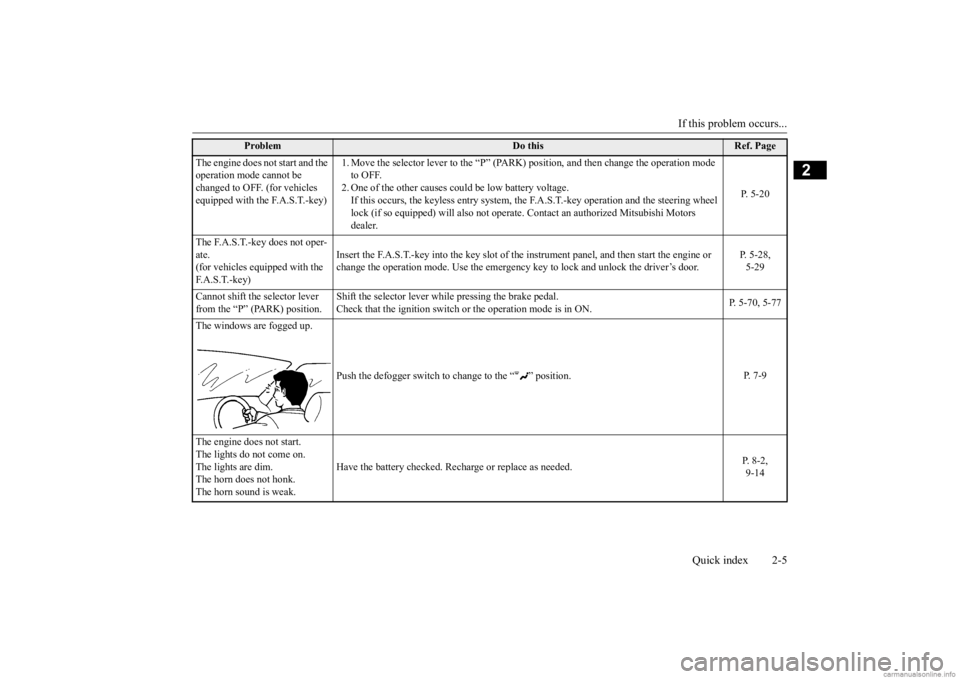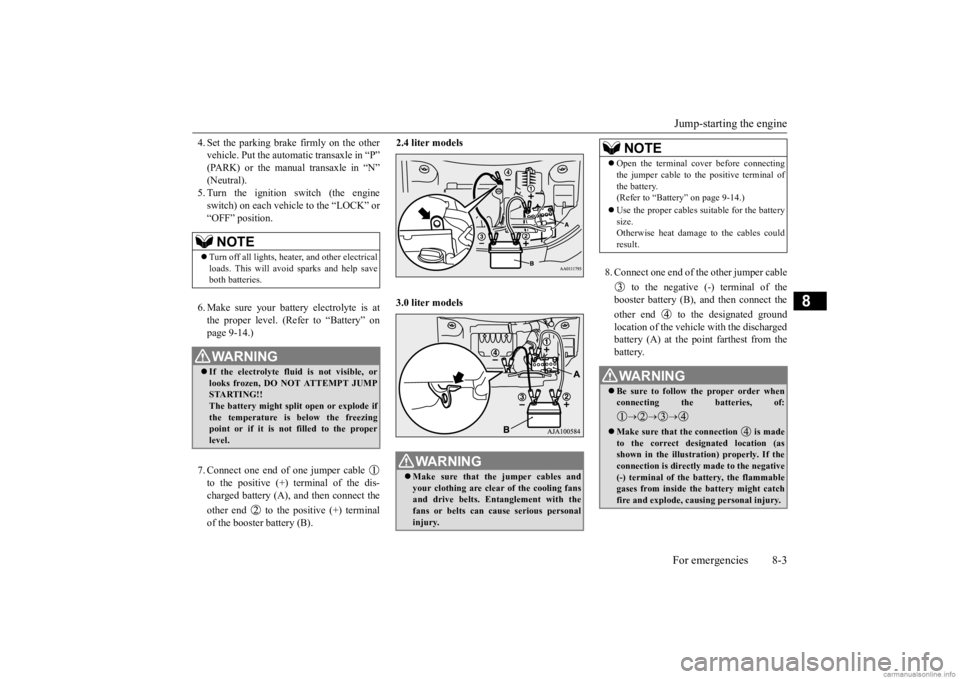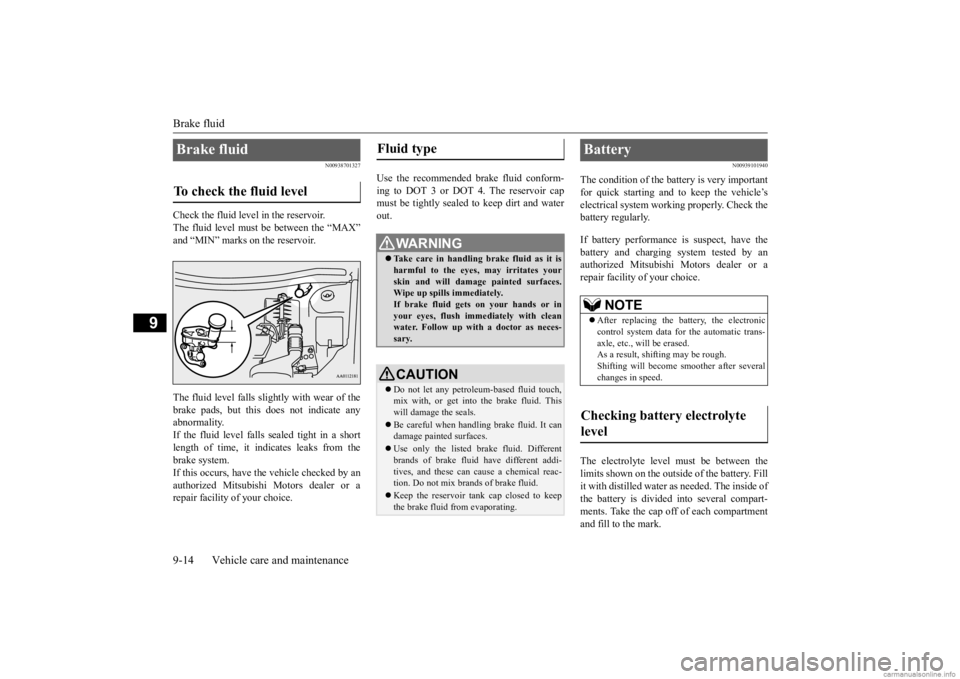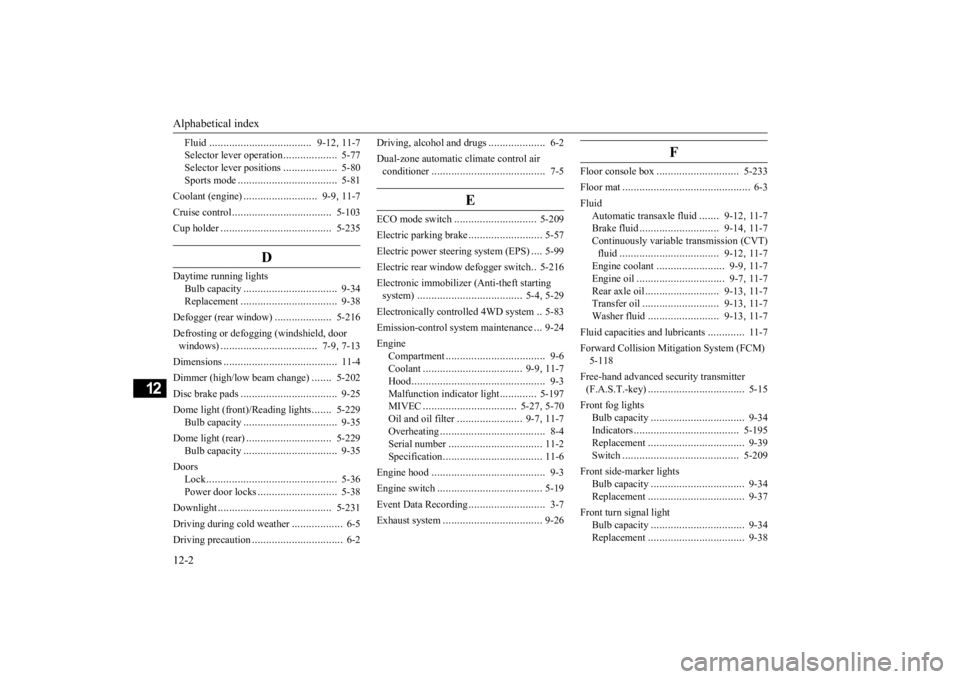9-14 MITSUBISHI OUTLANDER 2020 Owner's Manual (in English)
[x] Cancel search | Manufacturer: MITSUBISHI, Model Year: 2020, Model line: OUTLANDER, Model: MITSUBISHI OUTLANDER 2020Pages: 443, PDF Size: 60.03 MB
Page 18 of 443

If this problem occurs...
Quick index 2-5
2
The engine does not start and the operation mode cannot be changed to OFF. (for vehicles equipped with the F.A.S.T.-key)
1. Move the selector lever to the “P” (PARK)
position, and then cha
nge the operation mode
to OFF.2. One of the other causes could be low battery voltage. If this occurs, the keyless entry system, the
F.A.S.T.-key operation
and the steering wheel
lock (if so equipped) will also not operate
. Contact an authorized Mitsubishi Motors
dealer.
P. 5-20
The F.A.S.T.-key does not oper- ate.(for vehicles equipped with the F. A . S . T. - k e y )
Insert the F.A.S.T.-key into the key slot of the instrument panel, and then start the engine or change the operation mode. Use the emergency
key to lock and unlock the driver’s door.
P. 5-28, 5-29
Cannot shift the selector lever from the “P” (PARK) position.
Shift the selector lever while pressing the brake pedal. Check that the ignition switch or
the operation mode is in ON.
P. 5-70, 5-77
The windows are fogged up.
Push the defogger switch to change to the “ ” position.
P. 7-9
The engine does not start. The lights do not come on. The lights are dim. The horn does not honk.The horn sound is weak.
Have the battery checked. Rech
arge or replace as needed.
P. 8-2, 9-14
Problem
Do this
Ref. Page
BK0278200US.book 5 ページ 2019年4月10日 水曜日 午前10時59分
Page 356 of 443

Jump-starting the engine For emergencies 8-3
8
4. Set the parking brake firmly on the other vehicle. Put the automatic transaxle in “P”(PARK) or the manual transaxle in “N” (Neutral). 5. Turn the ignition switch (the engineswitch) on each vehicle to the “LOCK” or “OFF” position. 6. Make sure your batt
ery electrolyte is at
the proper level. (Refer to “Battery” onpage 9-14.) 7. Connect one end of one jumper cable to the positive (+) terminal of the dis-charged battery (A),
and then connect the
other end to the positive (+) terminal of the booster battery (B).
2.4 liter models 3.0 liter models
8. Connect one end of the other jumper cable
to the negative (-) terminal of the booster battery (B), a
nd then connect the
other end to the designated ground location of the vehicl
e with the discharged
battery (A) at the point farthest from thebattery.
NOTE
Turn off all lights, heat
er, and other electrical
loads. This will avoid sparks and help saveboth batteries.WA R N I N G If the electrolyte flui
d is not visible, or
looks frozen, DO NOT ATTEMPT JUMP STARTING!!The battery might split open or explode if the temperature is below the freezing point or if it is not filled to the properlevel.
WA R N I N G Make sure that the jumper cables and your clothing are clear of the cooling fans and drive belts. Entanglement with the fans or belts can ca
use serious personal
injury.
NOTE
Open the terminal co
ver before connecting
the jumper cable to the positive terminal ofthe battery.(Refer to “Battery” on page 9-14.) Use the proper cables suitable for the battery size. Otherwise heat damage
to the cables could
result.WA R N I N G Be sure to follow the proper order when connecting the batteries, of:
Make sure that the connection is made to the correct designated location (as shown in the illustration) properly. If the connection is directly made to the negative(-) terminal of the battery, the flammable gases from inside the battery might catch fire and explode, caus
ing personal injury.
BK0278200US.book 3 ページ 2019年4月10日 水曜日 午前10時59分
Page 374 of 443

9
Vehicle care and maintenanceService precautions ..........................................................................9-2 Catalytic converter ...........................................................................9-2 Engine hood .........
...........
...........
............
...........
.........
........
.........
.....9-3
View of the engine compartment .....................................................9-6 Engine oil and oil filter ....................................................................9-7 Engine coolant .................................................................................9-9Air cleaner filter .............................................................................9-10 Automatic transaxle fluid (if so equipped) .....................................9-12 Continuously variable transmission
(CVT) fluid (if so equipped) .9-12
Transfer oil (All-wheel drive models) ...........................................9-13 Rear axle oil (All-wheel drive models) .........................................9-13 Washer fluid ...................................................................................9-13Brake fluid .....................................................................................9-14 Battery ............................................................................................9-14 Tires ...............................................................................................9-16Brake pedal free play .....................................................................9-23 Parking brake lever stroke (if so equipped) ....................................9-23 Wiper blades ..................................................................................9-24Emission-control system maintenance ..........................................9-24 General maintenance .....................................................................9-25 For cold and snowy weather ..........................................................9-26Fusible links ...................................................................................9-27 Fuses ..............................................................................................9-27 Replacement of light bulbs ............................................................9-33Vehicle care precautions ................................................................9-42 Cleaning the inside of your vehicle .......
...........
...........
...........
.......9-42
Cleaning the outside of your vehicle .....
...........
...........
...........
.......9-43
BK0278200US.book 1 ページ 2019年4月10日 水曜日 午前10時59分
Page 387 of 443

Brake fluid 9-14 Vehicle care and maintenance
9
N00938701327
Check the fluid level in the reservoir. The fluid level must be between the “MAX” and “MIN” marks on the reservoir. The fluid level falls slightly with wear of the brake pads, but this
does not indicate any
abnormality.If the fluid level falls se
aled tight in a short
length of time, it indi
cates leaks from the
brake system.If this occurs, have the vehicle checked by an authorized Mitsubishi Motors dealer or a repair facility of your choice.
Use the recommended brake fluid conform- ing to DOT 3 or DOT 4. The reservoir cap must be tightly sealed to keep dirt and waterout.
N00939101940
The condition of the battery is very important for quick starting and to keep the vehicle’s electrical system working properly. Check thebattery regularly. If battery performance is suspect, have the battery and charging system tested by an authorized Mitsubishi Motors dealer or a repair facility of your choice. The electrolyte level
must be between the
limits shown on the outside
of the battery. Fill
it with distilled water
as needed. The inside of
the battery is divided into several compart- ments. Take the cap off of each compartment and fill to the mark.
Brake fluid To check the fluid level
Fluid type
WA R N I N G Take care in handling brake fluid as it is harmful to the eyes, may irritates yourskin and will damage
painted surfaces.
Wipe up spills immediately. If brake fluid gets on your hands or inyour eyes, flush imme
diately with clean
water. Follow up with a doctor as neces- sary.CAUTION Do not let any petrol
eum-based fluid touch,
mix with, or get into the brake fluid. This will damage the seals. Be careful when handling brake fluid. It can damage painted surfaces. Use only the listed brake fluid. Different brands of brake fluid have different addi- tives, and these can cause a chemical reac- tion. Do not mix brands of brake fluid. Keep the reservoir ta
nk cap closed to keep
the brake fluid from evaporating.
Battery
NOTE
After replacing the battery, the electronic control system data for the automatic trans-axle, etc., will be erased. As a result, shifting may be rough. Shifting will become smoother after severalchanges in speed.
Checking battery electrolyte level
BK0278200US.book 14 ページ 2019年4月10日 水曜日 午前10時59分
Page 434 of 443

Alphabetical index
12-1
12
Numerics
12 V power outlets
............................
5-221
4-wheel drive operation
.......................
5-88
A
Accessory (installation)
.........................
3-6
Active stability control (ASC)
............
5-100
Adaptive Cruise C
ontrol System (ACC)
.......
5-107 Air cleaner filter
.................................
9-10
Air conditioner
Dual-zone automatic climate control air conditioner
.....................................
7-5
Important air condi
tioning operating tips
..
7-13
Air purifier
.........................................
7-14
Airbag
...............................................
4-35
All-wheel drive operation
....................
5-88
Aluminum wheels
...............................
9-46
Anti-lock braking system
.....................
5-97
Arm rest
.............................................
4-10
Assist grip
........................................
5-239
Automatic high beam system
.............
5-203
Automatic transaxle
............................
5-70
Fluid
.....................................
9-12
, 11-7
Selector lever operation
...................
5-70
Selector lever positions
...................
5-73
Sports mode
...................................
5-73
B
Back-up light
Bulb capacity
.................................
9-34
Replacement
..................................
9-40
Ball joint, steering linka
ge seals, drive shaft
boots
...............................................
9-26
Battery
..............................................
9-14
Charging system warning light
.......
5-197
Checking battery
electrolyte level
....
9-14
Disconnection and connection
.........
9-15
During cold weather
.......................
9-15
Specification
..................................
11-6
Blind Spot Warning (BSW)
................
5-127
Bottle holders
....................................
5-236
Brake
Fluid
.....................................
9-14
, 11-7
Brake assist
........................................
5-97
Braking
Anti-lock braking system
................
5-97
Braking
...........................................
6-5
Hose
.............................................
9-25
Pad wear alarm
..............................
5-93
Parking brake
.................................
5-56
Pedal
.............................................
5-92
Pedal free play
...............................
9-23
Power brakes
.................................
5-93
Service brake
.................................
5-92
Warning lights and buzzer
.............
5-196
Break-in recommendations
....................
5-3
Bulb location and capacity
...................
9-34
C
California Perchl
orate Materials
Requirements
.....................................
3-7
Capacities
..........................................
11-7
Card holder
......................................
5-232
Cargo area cover
...............................
5-237
Cargo loads
........................................
6-10
Cargo room light
...............................
5-230
Bulb capacity
.................................
9-35
Catalytic converter
................................
9-2
Cautions on the handling of all-wheel drive vehicles
............................................
5-91
Certification label
...............................
11-3
Charging system warning light
...........
5-197
Child restraint systems
........................
4-27
Child safety locks for rear door
............
5-40
Cleaning
Inside of your vehicle
......................
9-42
Outside of your vehicle
...................
9-43
Coat hook
.........................................
5-239
Consumer information
.........................
10-2
Continuously variable transmission (CVT)
...
5-76
BK0278200US.book 1 ページ 2019年4月10日 水曜日 午前10時59分
Page 435 of 443

Alphabetical index 12-2
12
Fluid
....................................
9-12
, 11-7
Selector lever operation
...................
5-77
Selector le
ver positions
...................
5-80
Sports mode
...................................
5-81
Coolant (engine)
..........................
9-9
, 11-7
Cruise control
...................................
5-103
Cup holder
.......................................
5-235
D
Daytime running lights
Bulb capacity
.................................
9-34
Replacement
..................................
9-38
Defogger (rear window)
....................
5-216
Defrosting or defogging (windshield, door windows)
..................................
7-9
, 7-13
Dimensions
........................................
11-4
Dimmer (high/lo
w beam change)
.......
5-202
Disc brake pads
..................................
9-25
Dome light (front)/Reading lights
.......
5-229
Bulb capacity
.................................
9-35
Dome light (rear)
..............................
5-229
Bulb capacity
.................................
9-35
Doors
Lock
..............................................
5-36
Power door locks
............................
5-38
Downlight
........................................
5-231
Driving during cold weather
..................
6-5
Driving precaution
................................
6-2
Driving, alcohol and drugs
....................
6-2
Dual-zone automatic climate control air conditioner
........................................
7-5
E
ECO mode switch
.............................
5-209
Electric parking brake
..........................
5-57
Electric power steering system (EPS)
....
5-99
Electric rear window
defogger switch
..5-216
Electronic immobilizer (Anti-theft starting system)
.....................................
5-4
, 5-29
Electronically cont
rolled 4WD system
..5-83
Emission-control system maintenance
...
9-24
Engine
Compartment
...................................
9-6
Coolant
...................................
9-9
, 11-7
Hood
...............................................
9-3
Malfunction indicator light
.............
5-197
MIVEC
.................................
5-27
, 5-70
Oil and oil filter
.......................
9-7
, 11-7
Overheating
.....................................
8-4
Serial number
.................................
11-2
Specification
...................................
11-6
Engine hood
........................................
9-3
Engine switch
.....................................
5-19
Event Data Recording
...........................
3-7
Exhaust system
...................................
9-26
F
Floor console box
.............................
5-233
Floor mat
.............................................
6-3
Fluid
Automatic transaxle fluid
.......
9-12
, 11-7
Brake fluid
............................
9-14
, 11-7
Continuously variable transmission (CVT) fluid
...................................
9-12
, 11-7
Engine coolant
........................
9-9
, 11-7
Engine oil
...............................
9-7
, 11-7
Rear axle oil
..........................
9-13
, 11-7
Transfer oil
...........................
9-13
, 11-7
Washer fluid
.........................
9-13
, 11-7
Fluid capacities and lubricants
.............
11-7
Forward Collision Miti
gation System (FCM)
5-118 Free-hand advanced security transmitter (F.A.S.T.-key)
..................................
5-15
Front fog lights
Bulb capacity
.................................
9-34
Indicators
.....................................
5-195
Replacement
..................................
9-39
Switch
.........................................
5-209
Front side-marker lights
Bulb capacity
.................................
9-34
Replacement
..................................
9-37
Front turn signal light
Bulb capacity
.................................
9-34
Replacement
..................................
9-38
BK0278200US.book 2 ページ 2019年4月10日 水曜日 午前10時59分